 Dealing with a unique terrain doesn’t have to feel like treading on a slippery slope. Landscape designers can help you find creative solutions to overcome almost any problem that exists on your lot. Sloping terrain, drainage and runoff problems, climate conditions and privacy concerns are just a few of the typical challenges around the lake that can affect the layout and plant selections for your yard’s landscape.
Dealing with a unique terrain doesn’t have to feel like treading on a slippery slope. Landscape designers can help you find creative solutions to overcome almost any problem that exists on your lot. Sloping terrain, drainage and runoff problems, climate conditions and privacy concerns are just a few of the typical challenges around the lake that can affect the layout and plant selections for your yard’s landscape.
First, determine your lawn’s priorities. Do you need to protect a sloping lawn from erosion during every thunderstorm, or do you need to block out gusty winds? These are two of the most common problems around the lake. A landscape designer is qualified to offer troubleshooting advice specific for any of these unique site challenges.
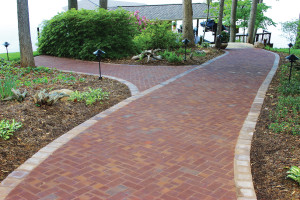 Dealing with a Sloping Terrain
Dealing with a Sloping Terrain
Hillside homes provide fantastic panoramic views—but they can also present some of the most challenging terrain to landscape. Undoubtedly, you want to protect your views, for yourself and your neighbors.
One common way to deal with a sloping lawn is to install a series of terraces by carefully cutting into the slope of the lawn—gently leveling the grade and shoring up the sides with retaining walls engineered to protect the slope and provide erosion control. Any time you cut into a slope, you compromise its integrity; therefore, the less aggressive you are about it, the better. For this reason, it’s best to create more, narrower steps in your terrace design than fewer, steeper ones.
Mark Maslow of Southern Landscape Group says, “It is important to carefully plan terrace construction at Smith Mountain Lake because the space that’s available for construction can be limited, in some cases, due to the Shoreline Management Plan’s prohibition on excavation, terraces and retaining walls.”
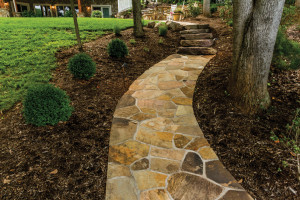 The purpose of the Shoreline Management Plan is to provide guidelines and regulations for shoreline development at the lake—protecting and enhancing its resources so it can be enjoyed for many generations to come. The Federal Energy Regulatory Commission, which regulates utilities nationwide, updated the plan with a set of new stipulations about what homeowners can and can’t do along the shoreline of Smith Mountain Lake in January of last year.
The purpose of the Shoreline Management Plan is to provide guidelines and regulations for shoreline development at the lake—protecting and enhancing its resources so it can be enjoyed for many generations to come. The Federal Energy Regulatory Commission, which regulates utilities nationwide, updated the plan with a set of new stipulations about what homeowners can and can’t do along the shoreline of Smith Mountain Lake in January of last year.
Maslow says the top priority, even above aesthetics, when designing a terrace should be to create a suitable route for water runoff. He says that a meandering path and terrace may be the best option for your lot’s unique terrain, since erosion occurs when water flows too swiftly over a steep gradient. A meandering path will slow the rate of the water flow, allowing it to zigzag across the landscape on its way down to the lake.
Construction provisions such as those outlined in the Shoreline Management Plan are put in place to protect the lake, and if you plan accordingly, you can design terrace walls that both comply with the rules and suit your aesthetic needs. In the case of designing terraces, it’s important to work with a landscaping professional to explore your options and make the right plan for your lot’s particular terrain.
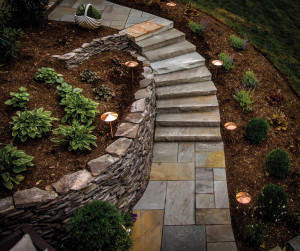 Hillside Paths and Walkways
Hillside Paths and Walkways
When the only access to the house from the water is directly up a slope, it can pose a daunting challenge for visitors. To ensure that people can easily and safely find their way up a slope, it is important to install a paved path. Paved steps that traverse the hillside will not only provide access, but add visual interest as it breaks up the slope, making it appear less imposing.
Jay Reed of Seven Oaks Landscape-Hardscape says that on hillsides and sloping lots, concrete pavers are a practical and versatile choice for walkways, for reasons of both aesthetics and safety. He explains, “Concrete pavers come in so many different shapes, colors and textures—you can create a truly custom look to complement your home.” Reed says that concrete pavers are easy to clean and that doing so won’t damage the product. “Concrete can withstand wintertime freeze and thaw conditions, and exposure to lots of sun and water. That makes it an ideal choice at the lake,” he says.
If your yard has only a gentle slope, you may not need any drastic measures at all. A slight slope can be corrected with minimal grading and planting grass. Once established, the roots of the grass will work to stabilize the soil and hold it in place. However, keep in mind that it is more difficult to mow a lawn on a slope versus a lawn on flat ground. Free-growing, unmowed ornamental grasses and groundcover plants might be a good choice, since they can also help prevent surface erosion by binding the surface tightly and covering it with dense foliage.
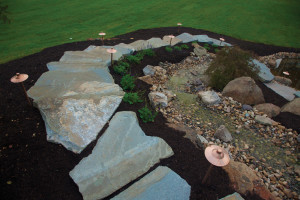 The Ups and Downs of Hillside Irrigation
The Ups and Downs of Hillside Irrigation
For those with a grass-covered hillside lot, Chris Templeton of CLC, Incorporated says you should use the slope to your advantage to keep your lawn healthy. Templeton says that most turf prefers extended watering times, applied less frequently. He says, “This watering tactic is deeply penetrating and creates deep root structures. Roots have to work harder and grow deeper to get their water.”
An irrigation system on a hillside requires a different setup than what you might have on a flat lot. On a flat lot, you’d have evenly spaced sprinkler heads to get even coverage; but Templeton explains, “To get the best water distribution on a hilly lot, the bulk of your sprinkler heads should be high-volume, rotor sprinkler heads placed along the upper contour of the hillside.” He says that as these high-volume sprinkler heads distribute water, some will naturally work its way down the slope and help water other parts of the lawn along its way. On the low end of the hill, Templeton recommends low-volume sprinkler heads with check valves, so you don’t end up with a soggy marsh at the bottom of your hill. Templeton explains that check valves prevent any water remaining in the pipes after the irrigation system has been shut off from draining out, thus reducing the chance of erosion on the landscape at the bottom of the slope.
Because many slopes are planted with groundcover (instead of turf), Templeton says that drip irrigation is also a good option for hilly lots because it offers slow, controlled-release watering, which helps eliminate runoff and encourages healthy root growth.
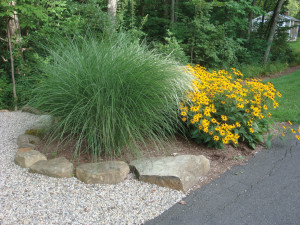 Drainage Problems
Drainage Problems
Rainfall can really set drainage problems in gear. After heavy downpours, poorly drained sites can become flooded and increase the potential for mudslides or damage to your home and garden from erosion. You or your landscape designer may want to dig a test hole to evaluate how fast your soil drains.
To do this, dig a hole about two feet deep and as wide. Fill it to the top with water. If it drains away within an hour, your drainage is excellent. If it takes 12 hours to drain, there may be a problem. If it takes more than 24 hours to drain, then a serious problem could affect the root zone of trees and shrubs.
Plants and shrubs are natural protectors of soil, slowing the speed of water runoff and reducing surface scouring on your lawn. Landscaping your lawn with a combination of spreading plants and deeply rooted shrubs will help your lawn attain its best chance for underground slope stability and protect it from runoff problems. Why? Plants cover the ground with low foliage, diffusing raindrops and protecting the surface soil from a deluge. When plant roots spread, they protect large areas of your lawn by binding the surface soil. When shrubs root down into the subsoil, they anchor not just themselves, but the surrounding subsurface soil, too.
Screening Out Wind, Adding Privacy
If wind is a chronic problem at your house, you can create windbreaks to protect specific outdoor living spaces and make them more comfortable. A windbreak is a fence or wall that blocks the wind—it can be all natural or a manmade structure. A hedgerow made of shrubs is a great way to protect a patio or deck, helping keep the grill aflame and your hair from being tousled into a tangled mess.
Planting a short, dense hedge around your outdoor entertaining spaces can be an effective windbreak. Patio or deck dwellers will still be able to sit in the protected area and gaze over the top of the barrier to see the view. Regular shearing can help control the height of your windbreak; however, it’s probably best to begin by selecting shrubs by their dimensions so there’ll be no need for aggressive pruning.
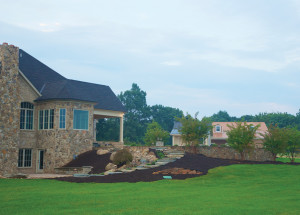 In the past, homeowners planted hedges made from one species, but designers are now moving toward using a more diverse combination of different types of shrubs. This way, if a disease were to strike one variety, there will be other plants remaining to maintain the integrity of the screen. Choose shrubs for compatibility, foliage density, longevity, adaptation to local climate, and overall pest and disease resistance.
In the past, homeowners planted hedges made from one species, but designers are now moving toward using a more diverse combination of different types of shrubs. This way, if a disease were to strike one variety, there will be other plants remaining to maintain the integrity of the screen. Choose shrubs for compatibility, foliage density, longevity, adaptation to local climate, and overall pest and disease resistance.
Maslow calls windbreaks and hedgerows a form of “buffer landscaping” and says that buffer landscaping helps preserve the cleanliness of the lake while simultaneously preserving the integrity of a hillside landscape. He explains, “When landscaping a hillside lot at the lake, plants are great allies when it comes to erosion control.” Maslow says that some lakeside buffer landscaping favorites include maiden grass, Virginia sweetspire, viburnum, the inkberry holly, and flowering shrubs like clethra and fothergilla. These native plants are hardy, drought tolerant and minimize erosion control on slopes.
Maslow says that it is always important to reference the Shoreline Management Plan’s list of acceptable plants before installing new landscaping, but that any of these natives should perform very well at the lake.
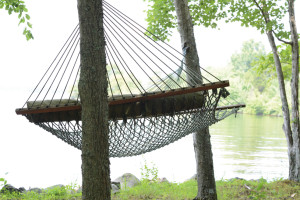 If your neighbor is mowing his lawn while you’re trying to relax in the hammock, privatizing your yard might be a top priority for you. A good landscaping plan will bring privacy to your lawn without making you feel fenced in and isolated from nature.
If your neighbor is mowing his lawn while you’re trying to relax in the hammock, privatizing your yard might be a top priority for you. A good landscaping plan will bring privacy to your lawn without making you feel fenced in and isolated from nature.
Jay Reed says that evergreens should be the anchor plants in any living fence. He suggests, “Nellie Stephens holly is an evergreen that has a red fruit and a saw-tooth shaped leaf. They are hardy and can be sheared and shaped. You’ll want to plant them in a group, but in a staggered formation—so they don’t look like a stiff line of soldiers on your lawn.” Reed suggests planting knockout roses, azaleas, spirea or hydrangea along with the holly to soften the overall look of the hedgerow and add bursts of color and other interesting textures to the windbreak or privacy screen.
There are other ways to increase the privacy of your yard, like adding a wooden fence, stone wall or lattice screen. Your property conditions, desired level of privacy, local building codes and personal taste will dictate which method you select. When privatizing your yard, be considerate of your neighbors. Avoid blocking desirable views from their property, and consider how trees or a privacy screen will impact their enjoyment of their outdoor spaces, too.
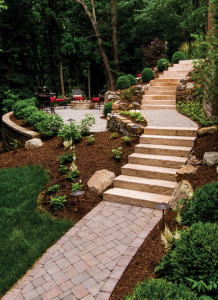 Sun Exposure
Sun Exposure
In the good old summertime, shade is necessary for outdoor living and entertaining. Where a landscape is fully exposed to the west, the cumulative heat of the setting sun can be a challenge. Here, all but the most rugged plants wilt under the strain. Choosing sun-adapted plants or using shade structures is essential to enjoying outdoor life in the hot zone.
Chris Templeton says he’s had success with several plants on hillside lots at Smith Mountain Lake. “For very sunny areas, purple coneflower works well, as does candy tuft, which is a low growing shrub that gives nice color. I also really like blue fescue. It’s a vibrant blue color, that’s not commonly seen.” He also recommends creeping phlox, columbine, salvia (also known as “Russian sage”) and coreopsis, which he describes as billowy and short with vibrant, daisy-like tiny yellow flowers.
Templeton says that in shady areas, or those that receive part sun/part shade, Lenten rose, false spirea (also known as astilbe) and mondo grass are all great options. His favorite variety of mondo grass is called “black lilyturf” which he says looks similar to liriope, in shades of black with purple blooms. Templeton says it offers a unique look and can be a great accent plant or bordering plant.
Your home should be your sanctuary where you can escape from the outside world. Addressing all the problems in your landscape will help you create that well-balanced and inviting space that brings you a worry-free peace of mind.
